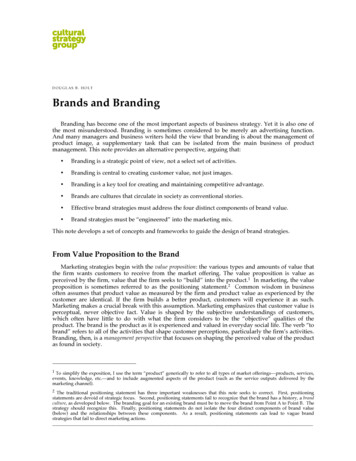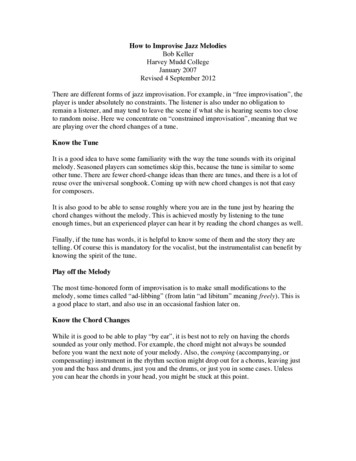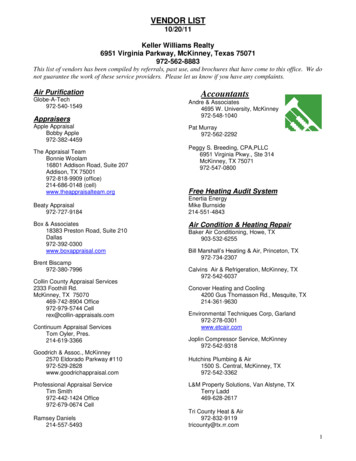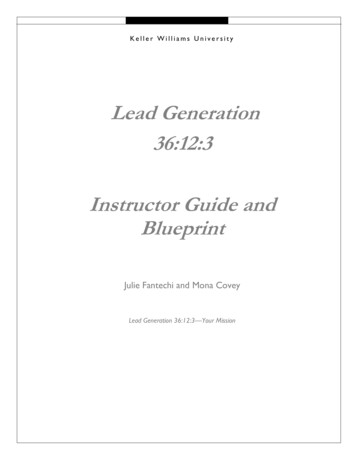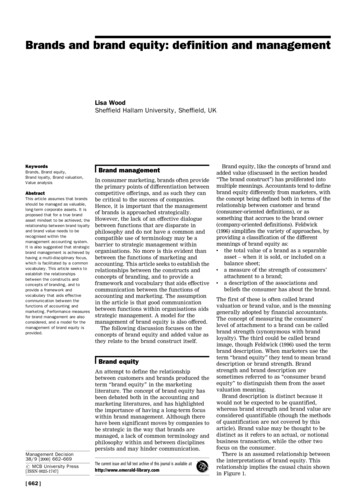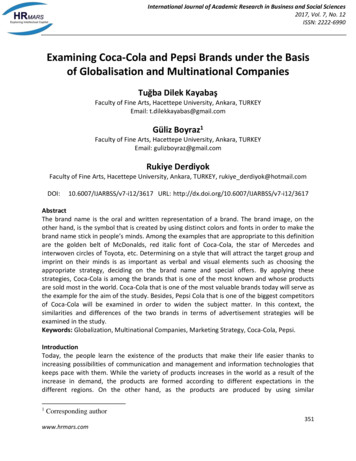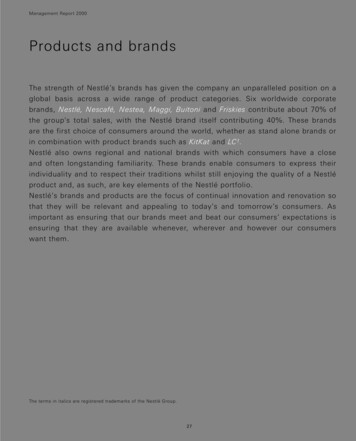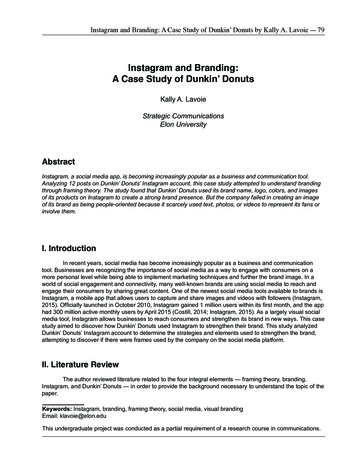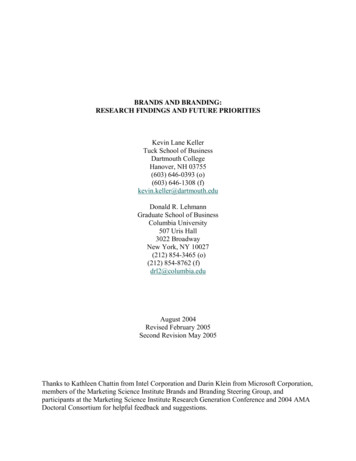
Transcription
BRANDS AND BRANDING:RESEARCH FINDINGS AND FUTURE PRIORITIESKevin Lane KellerTuck School of BusinessDartmouth CollegeHanover, NH 03755(603) 646-0393 (o)(603) 646-1308 (f)kevin.keller@dartmouth.eduDonald R. LehmannGraduate School of BusinessColumbia University507 Uris Hall3022 BroadwayNew York, NY 10027(212) 854-3465 (o)(212) 854-8762 (f)drl2@columbia.eduAugust 2004Revised February 2005Second Revision May 2005Thanks to Kathleen Chattin from Intel Corporation and Darin Klein from Microsoft Corporation,members of the Marketing Science Institute Brands and Branding Steering Group, andparticipants at the Marketing Science Institute Research Generation Conference and 2004 AMADoctoral Consortium for helpful feedback and suggestions.
BRANDS AND BRANDING:RESEARCH FINDINGS AND FUTURE PRIORITIESABSTRACTBranding has emerged as a top management priority in the last decade due to the growingrealization that brands are one of the most valuable intangible assets that firms have. Driven inpart by this intense industry interest, academic researchers have explored a number of differentbrand-related topics in recent years, generating scores of papers, articles, research reports, andbooks. This paper identifies some of the influential work in the branding area, highlighting whathas been learned from an academic perspective on important topics such as brand positioning,brand integration, brand equity measurement, brand growth, and brand management. The paperalso outlines some gaps that exist in the research of branding and brand equity and formulates aseries of related research questions. Choice modeling implications of the branding concept andthe challenges of incorporating main and interaction effects of branding as well as the impact ofcompetition are discussed.One sentence abstractMuch research progress has been made in the study of branding, but many opportunities stillexist.
3Kevin Lane Keller is the E. B. Osborn Professor of Marketing at the Tuck School of Business atDartmouth College. Keller's academic resume includes degrees from Cornell, Duke, andCarnegie-Mellon universities, award-winning research, and faculty positions at Berkeley,Stanford, and UNC. He has served as brand confidant to marketers for some of the world's mostsuccessful brands, including Accenture, American Express, Disney, Ford, Intel, Levi Strauss,Procter & Gamble, and SAB Miller. His textbook, Strategic Brand Management, has beenadopted at top business schools and leading firms around the world. With the 12th editionpublished in March 2005, he is also the co-author with Philip Kotler of the all-time best sellingintroductory marketing textbook, Marketing Management.Donald R. Lehmann is the George E. Warren Professor of Business at Columbia BusinessSchool at Columbia University. His research focuses on individual and group choice anddecision making, research methodology, the adoption of innovation, and new productdevelopment. He is particularly interested in knowledge accumulation, empiricalgeneralizations, and information use. He has published more than 80 articles and books, serveson the editorial boards of several academic journals, and is the founding editor of MarketingLetters. He is a past president of the Association for Consumer Research and a trustee andformer executive director of the Marketing Science Institute.
BRANDS AND BRANDING:RESEARCH FINDINGS AND FUTURE PRIORITIESINTRODUCTIONBrands serve several valuable functions. At their most basic level, brands serve asmarkers for the offerings of a firm. For customers, brands can simplify choice, promise aparticular quality level, reduce risk, and/or engender trust. Brands are built on the product itself,the accompanying marketing activity, and the use (or non-use) by customers as well as others.Brands thus reflect the complete experience that customers have with products. Brands also playan important role in determining the effectiveness of marketing efforts such as advertising andchannel placement. Finally, brands are an asset in the financial sense. Thus, brands manifesttheir impact at three primary levels – customer-market, product-market, and financial-market.The value accrued by these various benefits is often called brand equity.Our primary goal in this paper is to both selectively highlight relevant research onbuilding, measuring, and managing brand equity and to identify gaps in our understanding ofthese topics. We put considerable emphasis on the latter and suggest numerous areas of futureresearch.1 Five basic topics that align with the brand management decisions and tasks frequentlyperformed by marketing executives are discussed in detail: 1) developing brand positioning, 2)integrating brand marketing; 3) assessing brand performance; 4) growing brands; and 5)strategically managing the brand. We then consider the implications of this work for choicemodels. Finally, we present a simple framework for integrating the customer-market, product-1For commentary on the state of branding, see special issues of International Journal ofResearch in Marketing (Barwise 1993) and Journal of Marketing Research (Shocker et al. 1994).For a more exhaustive review of the academic literature on brands and brand management, seeKevin Lane Keller (2002), “Branding and Brand Equity,” in Handbook of Marketing, eds., BartWeitz and Robin Wensley, Sage Publications, London, 151-178.
2market, and financial-market level impact of brands and how the brand is created and developedby company actions.BRANDING DECISIONS AND TASKSDEVELOPING BRAND POSITIONINGBrand positioning sets the direction of marketing activities and programs – what thebrand should and should not do with its marketing. Brand positioning involves establishing keybrand associations in the minds of customers and other important constituents to differentiate thebrand and establish (to the extent possible) competitive superiority (Keller et al. 2002). Besidesthe obvious issue of selecting tangible product attribute levels (e.g., horsepower in a car), twoparticularly relevant areas to positioning are the role of brand intangibles and the role ofcorporate images and reputation.Brand IntangiblesAn important and relatively unique aspect of branding research is the focus on brand intangibles– aspects of the brand image that do not involve physical, tangible, or concrete attributes orbenefits (see Levy 1999). Brand intangibles are a common means by which marketersdifferentiate their brands with consumers (Park, Jaworski, and MacInnis 1986) and transcendphysical products (Kotler and Keller 2006). Intangibles cover a wide range of different types ofbrand associations, such as actual or aspirational user imagery; purchase and consumptionimagery; and history, heritage, and experiences (Keller 2001). A number of basic researchquestions exist concerning how brand tangibles and intangibles have their effects.Research Questions:
31. In developing brand equity, what is the role of product performance and objective ortangible attributes vs. intangible image attributes?2. Are intangible attributes formative (causes) or reflective (constructed) reasons forequity or choice? That is, are they considered a priori or “constructed” afterexperience with the brand?3. When and to what extent does recall of pleasant images (or “hot” emotions) shield abrand from less positive or even negative cognitive information?4. How much of brand equity is tied to unique attributes of a product? What happenswhen competitors copy these attributes?5. Which attribute associations are most stable and beneficial to a brand over the longrun (e.g., “high quality” and “upscale”) and which have limited useful life (e.g., being“hip”)?6. Can brands be thought of as simply a judgment bias or in terms of context effects inconsumer decision-making? What implications do these perspectives have for brandequity measurement and valuation?Brand Personality. Aaker (1997) examined the personality attributed to U.S. brands andfound they fall into five main clusters: 1) sincerity, 2) excitement, 3) competence, 4)sophistication, and 5) ruggedness. Aaker et al. (2001) found that three of the five factors alsoapplied to brands in both Japan and Spain, but that a “peacefulness” dimension replaced“ruggedness” both in Japan and Spain and a “passion” dimension emerged in Spain instead of“competency.” Aaker (1999) also found that different brand personality dimensions affecteddifferent types of people in different consumption settings. She interpreted these experimentalresults in terms of a "malleable self', which is composed of self-conceptions that can be madesalient by a social situation (see also Graef (1996, 1997)). While Azoulay and Kapferer (2003)have challenged the conceptual validity of this particular brand personality scale, theanthromorphism of a brand is common in both casual consumer conversation (e.g., “that brand is‘hip’”) and advertising messages.Research Questions:
41. How does brand personality affect consumer decision-making? Under whatcircumstances?2. Is brand personality of more strategic or tactical (e.g., in terms of the “look-and-feel”of ad executions) importance?3. What is the value of the different personality dimensions? Are certain personalitydimensions more valuable at driving preference or loyalty than others? Does thevalue vary by product category or by other factors?4. How stable are these various personality dimensions and what causes them to evolveor change? How does this stability compare to the stability of other types of brandassociations?Brand Relationships. Research has also explored the personal component of therelationship between a brand and its customers. Fournier (1998) examined the nature ofrelationships that customers have – as well as want to have – with companies (see also Fournierand Yao (1997) and Fournier, et al. (1998)). Fournier views brand relationship quality as multifaceted and consisting of six dimensions beyond loyalty or commitment along which consumerbrand relationships vary: 1) self-concept connection, 2) commitment or nostalgic attachment, 3)behavioral interdependence, 4) love/passion, 5) intimacy, and 6) brand partner quality. Shesuggested the following typology of metaphors to represent common customer-brandrelationships: 1) arranged marriages, 2) casual friends/buddies, 3) marriages of convenience, 4)committed partnerships, 5) best friendships, 6) compartmentalized friendships, 7) kinships, 8)rebounds/avoidance-driven relationships, 9) childhood friendships, 10) courtships, 11)dependencies, 12) flings, 13) enmities, 14) secret affairs, and 15) enslavements.While this typology contains most positive relationships, it may overlook a range ofpossible negative (e.g., adversary) and neutral (e.g., trading partner) ones. Aaker et al. (2004)conducted a two-month longitudinal investigation of the development and evolution ofrelationships between consumers and brands. They found that two factors – experiencing atransgression and the personality of the brand – had a significant influence on developmental
5form and dynamics. Aggarwal (2004) explored how relationship norms varied for two types ofrelationships: exchange relationships, in which benefits are given to others to get somethingback, and communal relationships, in which benefits are given to show concern for other’sneeds.Research Questions:1. How can a customer’s desired relationship be determined? Have concerns overprivacy and the increased use of customer data by firms resulted in customers wantingmore anonymous, transactional relationships, or do customers still desire closerelationships with companies? Does personalization of communication makecustomers feel empowered and/or valued, or do they feel more exploited?2. How can a desired customer relationship be cultivated by the company throughmarketing activities? How do different types of marketing activities such asadvertising, customer service, and on-line resources combine to affect customerrelationships?3. In a world where information is widely shared and discrimination is seen as bad,should a firm deal differently with customers who desire different relationships? Cancustomer relationships be segmented and can customers who desire different types ofrelationships be identified? Does this vary by product category or by competingproduct benefits?4. What is the relative profitability of different types of customer relationships? Shouldsome customers be encouraged and others discouraged or “fired”? Alternatively, arethere systematic ways to migrate unprofitable customers into profitable relationships?Brand Experience. Experiential marketing is an important trend in marketing thinking.Through several books and articles, Schmitt (1999, 2003) has developed the concept ofCustomer Experience Management (CEM), which he defines as the process of strategicallymanaging a customer’s entire experience with a product or company. According to Schmitt,brands can help to create five different types of experiences: Sense experiences involving sensory perception, Feel experiences involving affect and emotions, Think experiences which are creative and cognitive;
6 Act experiences involving physical behavior and incorporating individual actions andlifestyles, and Relate experiences that result from connecting with a reference group or culture.Research Questions1. What are the different means by which experiences affect brand equity? How canfirms ensure that experiences positively impact brand equity? More specifically, howcan advertising trigger positive experiences with a brand or make negative ones lesssalient or influential?2. How much of brand-related experiences are under the control of the company? Howcan they be effectively controlled?3. When and to what extent do customers respond – positively or negatively – toattempts to control their experiences? How do customers make attributions aboutcompany actions and attitudes toward control of experiences?4. How does
Branding has emerged as a top management priority in the last decade due to the growing realization that brands are one of the most valuable intangible assets that firms have. Driven in part by this intense industry interest, academic researchers have explored a number of different brand-related topics in recent years, generating scores of papers, articles, research reports, and books. This .

